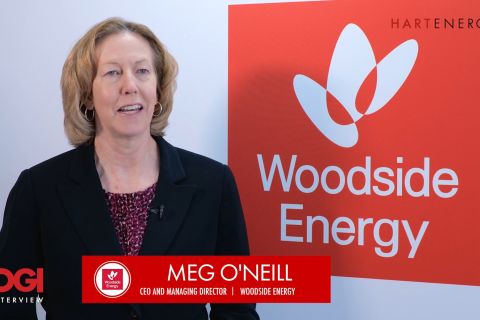
HOUSTON—The giant wind turbines slice through the sea air, their blades stretching 538 feet in diameter and reaching some 600 feet above the ocean surface as they generate enough clean electricity to power 60,000 homes.
Three Vestas V164s make up Principle Power’s WindFloat Atlantic project, a set of floating platforms each comprised of three columns moored to the seabed. This project is 20 km offshore Viana do Castelo, Portugal, and was the first floating wind farm in continental Europe. It was also the first to utilize semisubmersible technology and the first to obtain financing (60 million euros from European Investment Bank).
The structure is big, said Thalía Kruger, senior development manager of Principle Power, at the Offshore Technology Conference on May 4, but nimble enough to be tailored to a customer’s particular offshore environment.
As of 2020, global offshore wind projects were providing 34.4 gigawatts of electricity. By 2026, that capacity is expected to reach 94 GW, according to a Fortune Business Insights report.
WindFloat Alantic began operations in 2019 at a depth of 100m in Portugal, but the company’s first project, WindFloat 1, 5 km offshore Aguçadoura, Portugal, floats in only 45m of water. The Redwood Coast Offshore Wind Project, scheduled to go online in 2026, will operate in depths of 700-900m, 40 km offshore Humboldt County, Calif.
Because it floats, the three-column structure offers flexibility in water depth and seabed conditions that a fixed structure cannot. It also features a proprietary technology with damping plates and a hull system to provide stability.
WindFloat is “wind-turbine agnostic,” Kruger said. A Vestas V80 powers the WindFloat 1 project and turbines for future projects offshore the French Mediterranean coast, Wales and South Korea have yet to be chosen.
Bringing WindFloat to scale means wind farms of up to 100 units. The Korea Floating Wind project, 65 km offshore Ulsan City, South Korea, will consist of 60 to 100 turbines and generate up to 1,000 megawatts of electricity, beginning in 2026.
Potential for geothermal
Speeding up the energy transition requires oil and gas, said Karl Farrar, CEO of London-based CeraPhi Energy Ltd. at the same session, and existing oil and gas wells are essential to tapping into geothermal energy.
Geothermal energy is natural—it exists within the subsurface of the earth. CeraPhi’s technology employs water and/or steam to bring it to the surface, where it can be used to generate heat or clean electricity. The key drivers to develop geothermal, Farrar said, are lower costs and lower emissions.
Reusing existing wells allows generation of energy without drilling, which is essential in areas of Europe or states in New England that have banned fracking. The CeraPhi system incorporates a low exploration risk as it reuses or retrofits failed or depleted wells. No reservoir is required.
Usage of the energy produced varies depending on the heat levels:
- High, 100-120 degrees C: power generation or generation of hydrogen for clean electricity generation;
- Medium, 70-100 degrees C: heating networks or industrial processes; and
- Low, 30-70 degrees C: food processing and agriculture.
Farrar said his CeraPhi is partnering on projects with companies such as Chesapeake Energy, Williams Cos., Oxy and the California Resource Corp.
Recommended Reading
NAPE: Turning Orphan Wells From a Hot Mess Into a Hot Opportunity
2024-02-09 - Certain orphaned wells across the U.S. could be plugged to earn carbon credits.
Exxon Versus Chevron: The Fight for Hess’ 30% Guyana Interest
2024-03-04 - Chevron's plan to buy Hess Corp. and assume a 30% foothold in Guyana has been complicated by Exxon Mobil and CNOOC's claims that they have the right of first refusal for the interest.
Petrobras to Step Up Exploration with $7.5B in Capex, CEO Says
2024-03-26 - Petrobras CEO Jean Paul Prates said the company is considering exploration opportunities from the Equatorial margin of South America to West Africa.
The OGInterview: How do Woodside's Growth Projects Fit into its Portfolio?
2024-04-01 - Woodside Energy CEO Meg O'Neill discusses the company's current growth projects across the globe and the impact they will have on the company's future with Hart Energy's Pietro Pitts.
Deepwater Roundup 2024: Offshore Australasia, Surrounding Areas
2024-04-09 - Projects in Australia and Asia are progressing in part two of Hart Energy's 2024 Deepwater Roundup. Deepwater projects in Vietnam and Australia look to yield high reserves, while a project offshore Malaysia looks to will be developed by an solar panel powered FPSO.






